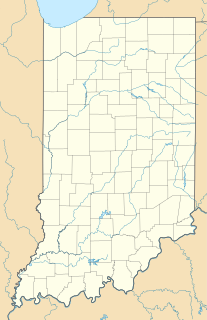| Blackwell–Tonkawa Municipal Airport | |||||||||||
|---|---|---|---|---|---|---|---|---|---|---|---|
| Summary | |||||||||||
| Airport type | Public | ||||||||||
| Owner | Cities of Blackwell & Tonkawa | ||||||||||
| Serves | Blackwell / Tonkawa, Oklahoma | ||||||||||
| Elevation AMSL | 1,030 ft / 314 m | ||||||||||
| Coordinates | 36°44′42″N097°20′58″W / 36.74500°N 97.34944°W | ||||||||||
| Runways | |||||||||||
| |||||||||||
| Statistics (2008) | |||||||||||
| |||||||||||
Source: Federal Aviation Administration [2] | |||||||||||
Blackwell–Tonkawa Municipal Airport( IATA : BWL, ICAO : KBKN, FAA LID : BKN, formerly 4O3) is a public use airport located in Kay County, Oklahoma, United States. The airport is five nautical miles (9 km) southwest of the central business district of Blackwell, Oklahoma and is owned by the cities of Blackwell and Tonkawa. [2]
An IATA airport code, also known as an IATA location identifier, IATA station code or simply a location identifier, is a three-letter code designating many airports around the world, defined by the International Air Transport Association (IATA). The characters prominently displayed on baggage tags attached at airport check-in desks are an example of a way these codes are used.

The ICAOairport code or location indicator is a four-letter code designating aerodromes around the world. These codes, as defined by the International Civil Aviation Organization and published in ICAO Document 7910: Location Indicators, are used by air traffic control and airline operations such as flight planning.

The Federal Aviation Administration (FAA) is a governmental body of the United States with powers to regulate all aspects of civil aviation in that nation as well as over its surrounding international waters. Its powers include the construction and operation of airports, air traffic management, the certification of personnel and aircraft, and the protection of U.S. assets during the launch or re-entry of commercial space vehicles. Powers over neighboring international waters were delegated to the FAA by authority of the International Civil Aviation Organization.
Contents
Although most U.S. airports use the same three-letter location identifier for the FAA and IATA, this airport is assigned BKN by the FAA and BWL by the IATA [1] (which assigned BKN to Balkanabat Airport in Balkanabat, Turkmenistan). [1]
A location identifier is a symbolic representation for the name and the location of an airport, navigation aid, or weather station, and is used for manned air traffic control facilities in air traffic control, telecommunications, computer programming, weather reports, and related services.

The International Air Transport Association is a trade association of the world’s airlines. Consisting of 290 airlines, primarily major carriers, representing 117 countries, the IATA's member airlines account for carrying approximately 82% of total available seat miles air traffic. IATA supports airline activity and helps formulate industry policy and standards. It is headquartered in Montreal, Quebec, Canada with Executive Offices in Geneva, Switzerland.

Balkanabat Airport, also known as Nebit Dag Airport, is a provincial airport located 4.5 kilometres (2.8 mi) southeast of Balkanabat in Turkmenistan. An opening ceremony of the new airport terminal was held on November 7, 2004. The terminal building is spread over 3,500 square metres and has a capacity of 200 passengers per hour. The runway can handle aircraft weighing up to 150 tonnes.












